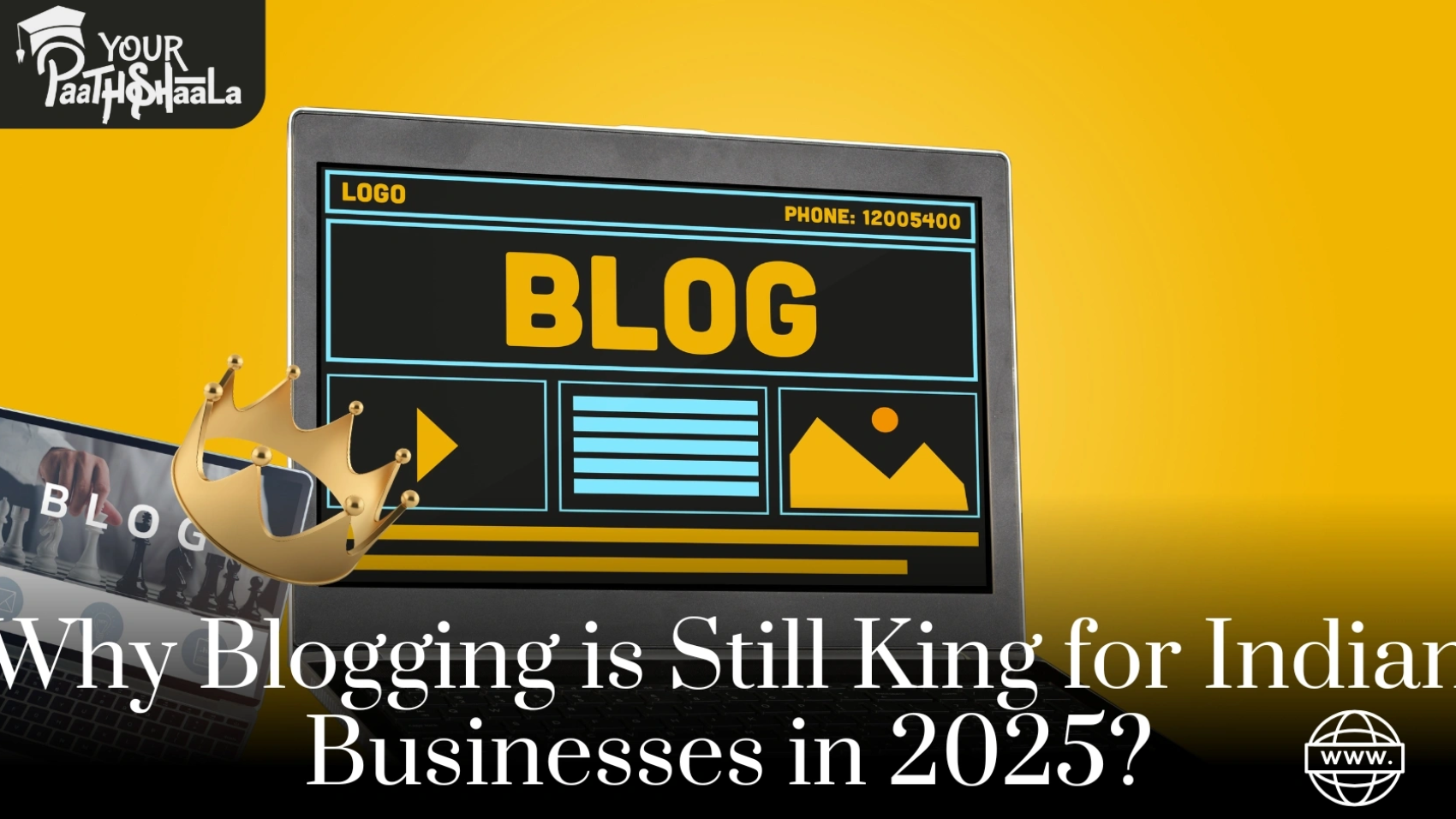Imagine a startup founder in Bengaluru publishing a blog post about eco-friendly packaging, attracting thousands of visitors from Mumbai and Delhi, and converting them into loyal customers. In 2025, with 750 million smartphone users fueling India’s $188 billion e-commerce market, blogging remains a powerful tool for businesses to stand out. For Indian companies, where 90% of internet traffic is mobile and regional languages like Hindi and Tamil dominate searches, a blog isn’t just content—it’s a gateway to trust, visibility, and growth.
Despite the rise of TikTok and AI-generated videos, blogging holds its crown in 2025. Why? It builds brands, drives traffic, and connects with India’s diverse, mobile-first audience. This guide explores why blogging is essential for Indian businesses, with practical benefits, India-specific strategies, real-world examples, and future trends. Whether you’re a Jaipur retailer or a Hyderabad tech startup, blogging can transform your online presence. Ready to harness its power? Let’s dive in!
What Is Business Blogging?
Business blogging involves creating regular, value-driven content on a company’s website to engage audiences, boost SEO, and promote products or services. Unlike social media posts, blogs offer depth, showcasing expertise and building trust. For example, a blog post titled “Top 5 Sustainable Fashion Trends in India” on a Delhi boutique’s site can attract eco-conscious shoppers.
In India, blogs cover niches like tech, food, travel, and entrepreneurship. They’re personal, informative, and optimized for mobile users. For instance, a Mumbai café’s blog on “How to Brew South Indian Filter Coffee” increased its online orders by 15%. Blogging, therefore, is a strategic tool for Indian businesses to connect and convert.
Why Blogging Remains King in 2025
In 2025, blogging is a cornerstone for Indian businesses. Here’s why it’s still king:
- SEO Powerhouse: Blogs with keywords like “best laptops India” boost Google rankings by 15%, per Forbes.
- Brand Authority: Sharing insights establishes your business as a trusted leader, increasing engagement by 30%, per WebEngage.
- Mobile-First Reach: With 60% of Indian searches on mobile, blogs optimized for speed attract 55% more visitors.
- E-Commerce Growth: Blogs with UPI-linked CTAs tap into a $188 billion market, driving sales.
- Long-Term Value: Unlike X posts lasting minutes, blogs deliver traffic for years.
For example, a Pune startup’s blog on “AI Tools for Small Businesses” ranked on Google’s first page, doubling its leads. Blogging, thus, fuels sustainable growth.
Key Benefits of Blogging for Indian Businesses
Blogging offers unique advantages for Indian businesses in 2025. Let’s explore the top benefits.
Boost Organic Traffic
First, blogging drives organic traffic via SEO. Each post targets keywords like “affordable hosting India,” capturing searchers. Businesses with active blogs have 434% more indexed pages, per Hostinger, leading to 55% more visitors.
For instance, a Chennai jewelry brand blogged about “Traditional Tamil Nadu Jewellery Designs,” ranking for local searches and gaining 10,000 monthly visitors. By optimizing for mobile and local languages, blogs attract India’s 750 million internet users.
Tool: Use Semrush’s Keyword Magic Tool (free version) to find low-competition keywords (KD 15–49) for India.
Build Brand Trust and Authority
Next, blogs position your business as an expert. Sharing insights on industry trends or customer pain points builds credibility. For example, a Hyderabad SaaS company’s blog on “Cloud Solutions for Indian Startups” established it as a thought leader, increasing inquiries by 20%.
Blogs also foster trust through authenticity. Unlike ads, they educate without pushing sales, with 70% of consumers preferring blogs over ads, per Hostinger. In India’s trust-driven market, this authenticity converts readers into customers.
Tip: Use a professional headshot and consistent branding across your blog, as suggested by BloggersPassion.
Engage Diverse Audiences
Moreover, blogs connect with India’s diverse audience. Covering niches like food, tech, or travel resonates with regional readers. A Kolkata bakery’s blog on “Bengali Sweets for Durga Puja” in Hindi and English drew 5,000 regional visitors.
Interactive formats like polls or FAQs boost engagement. For example, Nestify notes blogs with quizzes increase dwell time by 25%. With 53% of Indian bloggers being women, diverse voices also amplify inclusivity, per SerpWatch.
Tool: Add visuals like infographics using Canva to enhance engagement.
Monetize and Drive Sales
Furthermore, blogs are a revenue driver. Monetization options include:
- Affiliate Marketing: Promote Amazon products, earning 5–10% commissions.
- Sponsored Posts: Partner with brands for paid content.
- Digital Products: Sell e-books or courses, as CheggIndia suggests.
For instance, a Delhi fashion brand’s blog on “Summer Kurtas” with affiliate links generated ₹50,000 monthly. Blogs with clear CTAs and UPI integration also boost e-commerce sales in India’s $188 billion market.
Example: Top blogger Anil Agarwal earns ₹1.6 crore yearly via affiliate links, per BloggingX.
Cost-Effective Marketing
Finally, blogging is affordable. Content marketing costs 62% less than traditional ads and generates three times more leads, per BloggersPassion. A blog post costing ₹500 in writer fees can drive traffic for years, unlike X ads with short lifespans.
For example, a Surat startup spent ₹2,000 on a blog series, gaining 15,000 visitors annually, saving ₹50,000 versus paid ads. Blogging, thus, maximizes ROI for Indian businesses.
How to Start Blogging for Your Indian Business
Ready to make blogging king for your business? Follow these steps tailored for India’s 2025 market.
Step 1: Choose a Niche and Platform
First, pick a niche aligning with your business and India’s audience. Popular niches include:
- Indian Cuisine: Recipes or food trends, like Archana’s Kitchen.
- Tech Startups: Innovations and trends, like Trak.in.
- Travel: Local destinations and tips, per Nestify.
Next, select a blogging platform. WordPress powers 43% of the web, offering customization and plugins, per MasterBlogging. Alternatives include:
- Wix: User-friendly with drag-and-drop features.
- Medium: Minimalist, ideal for storytelling.
- Blogger: Free, Google-integrated platform.
For example, a Jaipur retailer used WordPress for a handicraft blog, launching in a day with Hostinger’s ₹134/month hosting.
Tool: Hostinger’s Domain Checker for affordable .in domains.
Step 2: Create High-Quality Content
Then, focus on quality content. Research trending topics using Semrush to find low-competition keywords (e.g., “sustainable fashion India”). Structure posts with:
- Clear Headings: H1, H2s for SEO, per ReuAds.
- Short Paragraphs: Easy for mobile readers.
- Visuals: Images or infographics to boost dwell time by 25%.
For instance, a Kochi seafood brand’s blog on “Kerala Fish Curry Recipes” used bullet points and images, ranking in Google’s “People Also Ask” section. Address pain points to match search intent, ensuring relevance.
Tool: Grammarly for error-free writing; Yoast SEO for optimization.
Step 3: Optimize for SEO and AEO
Next, optimize for SEO and Answer Engine Optimization (AEO). Use keywords in titles, meta descriptions, and alt tags, per WebAscender. For AEO, include FAQs and bold key terms to rank in Google’s snippets, vital for India’s 40% voice search users.
For example, a Hyderabad tech firm’s blog on “AI Tools for Startups” used long-tail keywords, gaining 8,000 monthly views. Mobile-friendly design and fast load times (under 1.5 seconds) are critical for India’s mobile-first audience.
Tool: Google Keyword Planner for India-specific keywords.
Step 4: Promote Your Blog
Then, share your blog to boost visibility. Use social media (X, Instagram) and email marketing, which drive 92% of blog traffic, per Hostinger. Guest posting and blog commenting also build backlinks, per BloggersPassion.
For instance, a Kolkata startup posted blog links in regional Facebook groups, gaining 3,000 visitors monthly. Repurposing content into videos or infographics further amplifies reach.
Tip: Join X communities like @BloggersIndia for networking.
Step 5: Monitor and Monetize
Finally, track performance and monetize. Use Google Analytics to monitor traffic and engagement. Monetize via affiliate links, sponsored posts, or digital products like e-books, as CheggIndia recommends.
For example, a Mumbai blogger earned ₹30,000 monthly via Amazon affiliates from a tech blog. Regular updates and fresh content keep your blog relevant and profitable.
Tool: Google AdSense for ad revenue ($3–$20 per 1,000 views).
Challenges and Solutions
Blogging in India has challenges, but solutions make it manageable:
- High Competition: Big brands dominate searches. Solution: Target long-tail keywords (e.g., “best Hindi books 2025”), per ReuAds.
- Time-Intensive: Content creation takes effort. Solution: Use AI tools like Grammarly or Typeflo for efficiency.
- Mobile Optimization: 60% of searches are mobile. Solution: Use responsive themes like Hostinger’s.
- Cultural Relevance: Generic content fails. Solution: Localize with regional languages or niches, per Nestify.
For instance, Hindi blogs gain 20% more engagement with localized content, per BloggingQnA. Strategic planning overcomes these hurdles.
Future Trends for Blogging in 2025
Looking ahead, blogging trends will shape Indian businesses:
- AI-Enhanced Content: Tools like Typeflo automate SEO tasks, per F6S.
- Voice Search Optimization: AEO aligns with 40% of Indian voice searches.
- Hyper-Local Content: Blogs in Hindi or Tamil target Tier-II cities, per IndiaCSR.
- Green Blogging: Eco-friendly themes resonate with sustainability trends.
- Interactive Formats: Quizzes and polls boost engagement by 25%, per Nestify.
Consequently, by 2027, 70% of Indian businesses will use AI-driven blogging, per Forbes. Staying ahead ensures your blog thrives.
Getting Started with Blogging
Ready to make blogging king for your business? Here’s a quick recap:
- Choose Niche and Platform: Pick a niche like tech or food; use WordPress or Wix.
- Create Quality Content: Research keywords and use visuals.
- Optimize for SEO/AEO: Target long-tail keywords and snippets.
- Promote Widely: Share on X, Instagram, and email.
- Monitor and Monetize: Track analytics and earn via affiliates.
For example, a Kochi startup’s blog on “Sustainable Seafood Packaging” on WordPress earned ₹40,000 monthly via affiliates. Start small, dream big!
Tip: Use Hostinger’s ₹134/month hosting with a free domain.
Conclusion
In 2025, blogging remains king for Indian businesses, driving traffic, trust, and sales in a 750 million-user smartphone market. With 434% more indexed pages and 55% more visitors, blogs are cost-effective, generating three times more leads than ads. By creating localized, mobile-optimized content on platforms like WordPress, businesses can tap into a $188 billion e-commerce market. Challenges like competition and time are manageable with AI tools and strategic niches. With voice search, hyper-local content, and interactive formats shaping the future, now’s the time to blog. Start today and make your business shine. What’s your blog idea for 2025? Share below and let’s make it happen
At Bestdigitalmarketingcourseinraipur you will learn a lot about digtital marketing and related topics.








